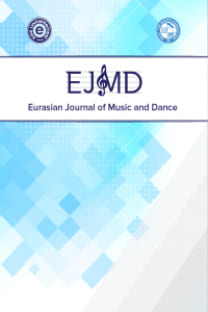KEMAN VE KLASİK GİTAR İCRA TEKNİĞİNİN KESİŞİMİ: PAGANİNİ VE SONATA CONCERTATA ESERİNİN TEKNİK ANALİZİ
Romantik dönem, bestecilerin eserlerinde kullandıkları üslubun değişimi ile birlikte, çalgı icrasında ustalık gerektiren ve bu bağlamda çalgı icra tekniğinin ve tınısal farklılaşmanın yoğun olarak görüldüğü bir dönem olarak değerlendirilebilmektedir. Klasik dönem içinde, stilistik açıdan kullanılması uygun görülmeyen birçok tekniğin kullanımının yaygın hale geldiği, solo çalgılarda keşfedilen yeni teknikler sayesinde farklı ekollerin ve muazzam bir konser repertuarının ortaya çıktığı görülmüştür. Değişen müzik pratikleri üzerinden çeşitli akımların ortaya çıkışıyla birlikte akustik algıların tamamen değişmesi, bestecileri eserlerinde solo performans unsurlarının yetkin niteliklerini ön plana çıkarmaları için özgür kılmıştır. “Virtüöz” kavramının ortaya çıktığı bu dönemde hiç şüphesiz birçok solist icracı olmasına rağmen, sahne sanatı üzerinden etkili icra sunumu, üst düzey bestecilik yönü ve birçok besteciyi kendisine hayran bıraktıran müzikal dehası ile göze çarpan Niccolò Paganini, dönem gereği çarpıcı bir örnek teşkil etmektedir. Paganini’nin keman için bestelediği eserlerdeki gösterdiği ustalığı klasik gitar eserlerinde de sergilediği görülmektedir. Keman ve klasik gitar ikilisi için bestelediği eserlerde klasik gitarı bir eşlikten ziyade bir solo çalgı olarak düşündüğü eser analizlerinde değerlendirilmektedir. Bu çalışma, verilerin toplanması ve değerlendirilmesi yönüyle betimsel araştırma teknikleri kullanılarak yapılmıştır. Nitel araştırma yöntemlerinden doküman inceleme yolu ile eserin kaynak olarak kullanılan edisyonu üzerinden değerlendirmeler yapılmıştır. Çalışmanın amacı, eserin icrasına yönelik gerekli teknik ön bilgilerin kazandırılmasını sağlamaktır. Çalışmada; Sonata Concertata’nın klasik gitar partisinde yoğun bir Klasik Dönem tarzının yansıtıldığı ve Paganini eserlerinde genel olarak rastlanılan keman sol el tekniklerinin kullanılmadığı, kemanın solist çalgı olarak ön planda olmayıp her iki çalgıya da eşit derecede önem verildiği sonuçlarına ulaşılmıştır.
Anahtar Kelimeler:
Keman, Klasik Gitar, İcra Tekniği, Analiz, Paganini
The Intersection of the Violin and Classical Guitar Playing: The Technical Analysis of Paganini and Sonata Concertata
Romantic period can be considered as a period that requires mastery in instrument performance with the change in the style used by composers in their works, and in this context, instrument playing technique and resonant differentiation are seen intensely. During the classical period, it was seen that the use of many techniques that were not considered suitable for use in stylistic terms became widespread, and thanks to the new techniques discovered in solo instruments, different écoles and an enormous concert repertoire emerged. With the emergence of various movements through changing musical practices, the complete change of acoustic perceptions has freed composers to emphasize the competent qualities of solo performance elements in their works. In this period when the concept of “virtuoso” emerged, Niccolò Paganini, who stands out with his effective performance presentation through the stage art, his high-level composition aspect and his musical genius that fascinated many composers, is a striking example for the period. Paganini’s mastery of the works he composed for violin is also shown in classical guitar works. In the works he composed for the violin and classical guitar duo, he considers the classical guitar as a solo instrument rather than an accompaniment. This study was conducted using descriptive research techniques in terms of data collection and evaluation. Through document analysis, one of the qualitative research methods, evaluations were made on the edition of the work used as a source. The aim of the study is to provide technical preliminary information required for the execution of the work. In the article; it has been concluded that Sonata Concertata’s classical guitar party reflects an intense Classical Period style and violin left-hand techniques commonly encountered in Paganini's works are not used, violin is not in the foreground as a soloist instrument, and both instruments are equally important.
Keywords:
Classical Guitar, Playing Technique, Analysis, Paganini, Violin,
___
- Aktüze, İ. (2007). Müziği okumak. Cilt-4. Pan Yayıncılık. İstanbul.
- Bone, P. J. (1972). The guitar and mandolin: Biographies of celebrated players and composers. Schott. London.
- Bozbuğa, N. U. (2001). Marfan Sendromu ve Nicolo Paganini. Türk Göğüs Kalp Damar Cerrahisi Dergisi, 9, 186-187.
- Carcassi, M. (1946). Classical Guitar Method. Carl Fischer. New York.
- Fétis, F. J. (1976). Biographical notice of Nicolo Paganini: With an analysis of his compositions: And a sketch of the history of the violin. New York.
- Galamian, I. (1962). Principles of violin playing and teaching by Iuan Galamian. Prentice-Hall. New Jersey.
- İlyasoğlu, E. (2009). Zaman içinde müzik: Başlangıcından günümüze örneklerle batı müziğinin evrimi. Yapı Kredi. İstanbul.
- Paganini, N. (n.d.). Sonata concertata für Gitarre und Violine. Frankfurt am Main: W. Zimmermann.
- Prodhomme, J. G. (1911). A Biography; Nicolo Paganini. Fischer. New York.
- Roberts, M. S. (2019). Niccolò Paganini was such a gifted violinist, people thought he sold his soul to the devil. https://www.classicfm.com/composers/paganini/niccolo- gifted-violinist-deal-with-devil/ Erişim Tarihi: 20.02.2019
- Tekiner, H. (2013) Paganini’nin Bağ Dokusu Hastalığı. Andante, 10(80). 58-59.
- Yıldırım, A. & Şimşek, H. (2011). Sosyal bilimlerde nitel araştırma yöntemleri. (8. Baskı), Seçkin Yayınevi. Ankara.
- ISSN: 2651-4818
- Yayın Aralığı: Yılda 2 Sayı
- Başlangıç: 2011
- Yayıncı: Ege Üniversitesi
Sayıdaki Diğer Makaleler
VİYOLONSEL EĞİTİMİNE DÖRDÜNCÜ POZİSYONDAN BAŞLAMAK ÜZERİNE GÖRÜŞ VE ÖNERİLER
İSMÂİL DEDE EFENDİ EKOLÜNDE USTA-ÇIRAK (HOCA-ÖĞRENCİ) İLİŞKİLERİ
OSMANLI BELGELERİ IŞIĞINDA ZURNA ve ZURNAZENLER
FAGOT KAMIŞI YAPIMINDA KARGI KAMIŞININ İNCELENMESİ VE FAGOT KAMIŞININ KALİTESİNİ ETKİLEYEN FAKTÖRLER
Burçe ULUBİLGİN ÇUHADAR, Aykut Barış ÇEREZCİOĞLU
ZİYA AYDINTAN’IN GİTAR METODU-I İSİMLİ ÇALIŞMASININ ANALİZİ
KEMAN VERNİKLEME GELENEĞİNDE SOLMAZ BİR RENK ELDE ETME YÖNTEMİ: ÇÖKELTME ve RUBIA TINCTORIUM
KABAK KEMANEDE YOZGAT (SÜRMELİ) TAVRI
19. YÜZYIL ROMANTİK VİYOLA SONATLARI EKSENİNDE YORUMA YÖNELİK MÜZİKAL VE TEKNİK YAKLAŞIMLAR
BİR MİM OYUNUNDAN HAREKETLE ÇAĞDAŞ DANS SOLO ESER KOREOGRAFİSİ ETÜT: SÖZSÜZ OYUN I
